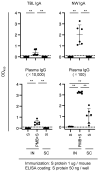Suitability of Polymyxin B as a Mucosal Adjuvant for Intranasal Influenza and COVID-19 Vaccines
- PMID: 38006059
- PMCID: PMC10675063
- DOI: 10.3390/vaccines11111727
Suitability of Polymyxin B as a Mucosal Adjuvant for Intranasal Influenza and COVID-19 Vaccines
Abstract
Polymyxin B (PMB) is an antibiotic that exhibits mucosal adjuvanticity for ovalbumin (OVA), which enhances the immune response in the mucosal compartments of mice. Frequent breakthrough infections of severe acute respiratory syndrome coronavirus 2 (SARS-CoV-2) variants indicate that the IgA antibody levels elicited by the mRNA vaccines in the mucosal tissues were insufficient for the prophylaxis of this infection. It remains unknown whether PMB exhibits mucosal adjuvanticity for antigens other than OVA. This study investigated the adjuvanticity of PMB for the virus proteins, hemagglutinin (HA) of influenza A virus, and the S1 subunit and S protein of SARS-CoV-2. BALB/c mice immunized either intranasally or subcutaneously with these antigens alone or in combination with PMB were examined, and the antigen-specific antibodies were quantified. PMB substantially increased the production of antigen-specific IgA antibodies in mucosal secretions and IgG antibodies in plasma, indicating its adjuvanticity for both HA and S proteins. This study also revealed that the PMB-virus antigen complex diameter is crucial for the induction of mucosal immunity. No detrimental effects were observed on the nasal mucosa or olfactory bulb. These findings highlight the potential of PMB as a safe candidate for intranasal vaccination to induce mucosal IgA antibodies for prophylaxis against mucosally transmitted infections.
Keywords: S protein; S1 subunit; SARS-CoV-2; hemagglutinin; influenza A virus; mucosal adjuvant; polymyxin B.
Conflict of interest statement
Authors Hironori Sakai and Wataru Hojo are employed by the company R&D, Cellspect Co., Ltd. The remaining authors declare that the research was conducted in the absence of any commercial or financial relationships that could be construed as a potential conflict of interest.
Figures




Similar articles
-
Polymyxins as novel and safe mucosal adjuvants to induce humoral immune responses in mice.PLoS One. 2013 Apr 11;8(4):e61643. doi: 10.1371/journal.pone.0061643. Print 2013. PLoS One. 2013. PMID: 23593492 Free PMC article.
-
Immunogenicity of Antigen Adjuvanted with AS04 and Its Deposition in the Upper Respiratory Tract after Intranasal Administration.Mol Pharm. 2020 Sep 8;17(9):3259-3269. doi: 10.1021/acs.molpharmaceut.0c00372. Epub 2020 Aug 27. Mol Pharm. 2020. PMID: 32787271
-
Modified pulmonary surfactant is a potent adjuvant that stimulates the mucosal IgA production in response to the influenza virus antigen.J Immunol. 2006 Jan 15;176(2):1122-30. doi: 10.4049/jimmunol.176.2.1122. J Immunol. 2006. PMID: 16394001
-
Intranasal Inactivated Influenza Vaccines: a Reasonable Approach to Improve the Efficacy of Influenza Vaccine?Jpn J Infect Dis. 2016;69(3):165-79. doi: 10.7883/yoken.JJID.2015.560. Jpn J Infect Dis. 2016. PMID: 27212584 Review.
-
Development of a safe and effective novel synthetic mucosal adjuvant SF-10 derived from physiological metabolic pathways and function of human pulmonary surfactant.Vaccine. 2022 Jan 24;40(3):544-553. doi: 10.1016/j.vaccine.2021.11.030. Epub 2021 Dec 6. Vaccine. 2022. PMID: 34887132 Review.
References
-
- Chen N., Zhou M., Dong X., Qu J., Gong F., Han Y., Qiu Y., Wang J., Liu Y., Wei Y., et al. Epidemiological and clinical characteristics of 99 cases of 2019 novel coronavirus pneumonia in Wuhan, China: A descriptive study. Lancet. 2020;395:507–513. doi: 10.1016/S0140-6736(20)30211-7. - DOI - PMC - PubMed
-
- Johns Hopkins Coronavirus Resource Center. [(accessed on 14 October 2023)]. Available online: https://coronavirus.jhu.edu/
Grants and funding
LinkOut - more resources
Full Text Sources
Medical
Miscellaneous

